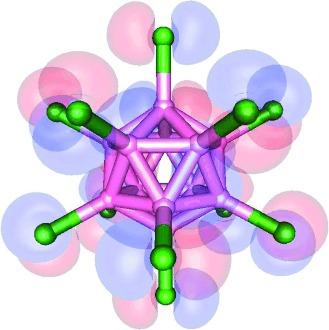On the Oxidation of the Three-Dimensional Aromatics [B12X12]2− (X=F, Cl, Br, I)
René T. Boeré, Janis Derendorf, Carsten Jenne,* Sylwia Kacprzak, Mathias Keßler, Rainer Riebau, Sebastian Riedel, Tracey L. Roemmele, Monika Rühle, Harald Scherer, Jonas Warneke, Thomas Vent-Schmidt, Stefan Weber – 2014
The perhalogenated closo-dodecaborate dianions [B₁₂X₁₂]²⁻ (X=H, F, Cl, Br, I) are three-dimensional counterparts to the two-dimensional aromatics C₆X₆ (X=H, F, Cl, Br, I). Whereas oxidation of the parent compounds [B₁₂X₁₂]²⁻ and benzene does not lead to isolable radicals, the perhalogenated analogues can be oxidized by chemical or electrochemical methods to give stable radicals. The chemical oxidation of the closo-dodecaborate dianions [B₁₂X₁₂]²⁻ with the strong oxidizer AsF₅ in liquid sulfur dioxide (SO₂) yielded the corresponding radical anions [B₁₂X₁₂]⁻˙ (X=F, Cl, Br). The presence of radical ions was proven by EPR and UV/Vis spectroscopy and supported by quantum chemical calculations. Use of an excess amount of the oxidizing agent allowed the synthesis of the neutral perhalogenated hypercloso-boranes B₁₂X₁₂ (X=Cl, Br). These compounds were characterized by single-crystal X-ray diffraction of dark blue B₁₂Cl₁₂ and [Na(SO₂)₆][B₁₂Br₁₂]⋅B₁₂Br₁₂. Sublimation of the crude reaction products that contained B₁₂X₁₂ (X=Cl, Br) resulted in pure dark blue B₁₂Cl₁₂ or decomposition to red B₉Br₉, respectively. The energetics of the oxidation processes in the gas phase were calculated by DFT methods at the PBE0/def2-TZVPP level of theory. They revealed the trend of increasing ionization potentials of the [B₁₂X₁₂]²⁻ dianions by going from fluorine to bromine as halogen substituent. The oxidation of all [B₁₂X₁₂]²⁻ dianions was also studied in the gas phase by mass spectrometry in an ion trap. The electrochemical oxidation of the closo-dodecaborate dianions [B₁₂X₁₂]²⁻ (X=F, Cl, Br, I) by cyclic and Osteryoung square-wave voltammetry in liquid sulfur dioxide or acetonitrile showed very good agreement with quantum chemical calculations in the gas phase. For [B₁₂X₁₂]²⁻ (X=F, Cl, Br) the first and second oxidation processes are detected. Whereas the first process is quasi-reversible (with oxidation potentials in the range between +1.68 and +2.29 V (SO₂, versus ferrocene/ferrocenium (Fc⁰/⁺))), the second process is irreversible (with oxidation potentials ranging from +2.63 to +2.71 V (SO₂, versus Fc⁰/⁺)). [B₁₂I₁₂]²⁻ showed a complex oxidation behavior in cyclic voltammetry experiments, presumably owing to decomposition of the cluster anion under release of iodide, which also explains the failure to isolate the respective radical by chemical oxidation.

